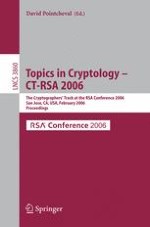The RSA R Conference, with over 15,000attendees, as well as over 225 sponsors and exhibitors, is the largest computer security event of the year. The Cr- tographers’ Track is one of the many parallel tracks. These proceedings contain the papers presented during the sixth edition. The tradition indeed started in 2001, and is by now well established: the Cryptographers’ Track at the RSA Conference is among the major events in cryptography. There were 72 submitted contributions, of which 22 were selected for p- sentation. They cover all aspects of cryptography (symmetric and asymmetric cryptography, constructions and attacks, new trends). In addition, the program includes two invited talks, by Xiaoyun Wang on “Cryptanalysis of Hash fu- tions and Potential Dangers,” and Philip MacKenzie on “Passwords Will Not Die: How Cryptography Can Help Deal with Them. ” All the submissions were reviewed by at least three members of the Program Committee. Iamverygratefultothe24membersfortheirhardandconscientious work.
